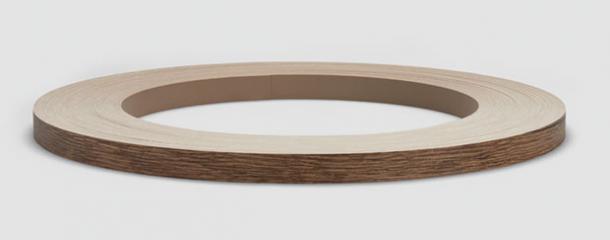PP edge materialPolypropylene (PP) edges are used in furniture construction as an alternative to PVC and ABS edges. As the manufacturing process is somewhat more difficult than that of ABS edgebanding, PP edgeband is preferably produced in large batch sizes. This explains why PP edge in the furniture industry are primarily processed by industrial companies. To achieve better adhesion of the hotmelt the back is coated with an adhesion promoter (primer). PP edgebands are also available for the zero-joint gluing process. Due to the characteristics of PP, edge made of this material can be found on kitchens, offices and bathroom furniture as well as on trade fairs and shop fittings and interior construction elements. Processing informationPP edges can be processed with all common automatic edgebanders and CNC-machining centres and suitable manual edge banding machines. Cross cut sawThe trimming saw should be assembled with saw blades with one-sided sharp toothing. The use of alternately toothed saw blades can lead to chipping, all on thin edge. Moulding aggregatesDyed polypropylene reacts to impacts with discoloration (Stress whitening). This can be minimized through using sharp milling tool with high concentricity in the edge milling units. The tool diameter should be approx. 70 mm, the spindle speed should be 12,000 to 18,000 rpm. ScraperThe depth of cut the Scraper should not exceed 0.15 mm, otherwise the discoloration described above will occur. Buffing unitThe action of the buffing wheels can remove stress whitening and adhesive residues if the rotation speed is approximately 1,400 rpm/min and the contact pressure is not too high. ExtractionSince the chips of polypropylene become statically charged during processing, they "stick" to the workpiece and machining units, especially to their tracer discs. An extraction capacity of 2.5 m³/s and the use of antistatic sprays ensure trouble-free workpiece processing. |
CNC machining centres, robots894
Edgebanding, edge processing629
Saws, cutting machines439
Planers, 4-sided moulders188
Routers, shapers, tenoners, profilers181
Drilling, mortising machines135
Presses, clamps, joining machines201
Sanding machines320
Mechanisation, storage, packing technology200
Surface coating152
Production lines127
Heating, drying, waste chopping62
Dust extraction, compressed air, vacuum134
Assembly, worktables15
Lathes29
Tools, sharpening technology91
Equipment, Other machines131

